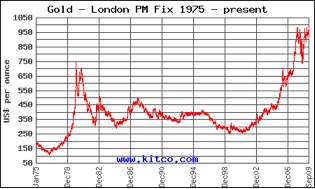Jewelry As an Investment
Say the economy is in flux (as it is now, for example) and your client has decided to invest in jewelry, since jewelry should hold its value. Does this make any difference to you, as agent or insurer?
Maybe your client hears that gold is a good investment and buys gold jewelry so she can enjoy wearing her precious metal rather than just putting gold bars and coins in a safe while they increase in value. Or maybe your client wants to insure a necklace that's been a family heirloom for three generations and she feels it can only gain in value. Or he's bought a package of loose gems and is holding them for resale at some future time.
These consumers have bought, or are holding, jewelry as an investment.
Gems and jewelry may seem like good investments. They are small, quite valuable for their size, and relatively durable.
There's also a general belief that anything rare, expensive or well-crafted will increase in value. Even many mass-produced objects that were originally cheap and commonplace become collector's items—like comic books, ruby glass, or any number of things you can see on Antiques Roadshow. Certainly jewelry would be likely to appreciate in value.
What's wrong with this assumption?
1. Jewelry is a commodity.
Regardless of its purchase price, jewelry is subject to market forces, and the market can be fickle. Prices of gems and metals fluctuate due to political crises, weather events, technological breakthroughs, and cultural trends. A gem can become popular because a movie star wears it. The fashion color of the season may affect gem choices.
The appraisal's valuation is based on the current replacement cost. It does not say anything about value at some future time of loss (perhaps 10 or 20 years from now)—though a settlement is based on the value at time of loss. That's why we recommend updating the valuation of quality jewelry every couple of years.
2. Older is not necessarily better.
Just because jewelry has been in the family for years, that doesn't mean it's valuable. Jewelry styles may go out of favor. Regardless of age or sentimental value, a piece that's considered “old fashioned” may have no buyers in today's market, and therefore little value. Even the cut of a gem can be outdated, as new technologies and expertise allow for more attractive cutting of the stone.
Also, old jewelry may not be what you think it is—or what the consumer thinks it is. A future newsletter will discuss in more detail insurance issues concerning antique and estate jewelry.
3. “Investment gems” are a common scam.
Selling gems “for investment” is a fraud that keeps resurfacing. Usually the gems arrive in a sealed package, which the buyer is cautioned not to open in order to preserve the gems' value. This is a major red flag!
A jeweler/appraiser must examine a gem to determine its value. No buyer should merely accept the word of a seller without impartial verification of the gem's quality. The buyer—and the insurer—should get an appraisal from a Graduate Gemologist, preferably a Certified Insurance Appraiser™.
4. Uncut stones and loose stones are a bad risk.
 Occasionally a naïve buyer will purchase a chunk of rough gemstone. The piece is of a good size, low-priced, and—as the seller tells him—he “can always have it cut later.” Many consumers don't realize how much color, clarity and especially cut determine a gem's valuation. Not to mention how difficult and expensive it is for a lay person to simply ”have it cut.”
Occasionally a naïve buyer will purchase a chunk of rough gemstone. The piece is of a good size, low-priced, and—as the seller tells him—he “can always have it cut later.” Many consumers don't realize how much color, clarity and especially cut determine a gem's valuation. Not to mention how difficult and expensive it is for a lay person to simply ”have it cut.”
Always be wary of clients who want to insure uncut, unpolished, or unmounted gemstones that are being held for some future use or sale. The intention may be deliberate insurance fraud.
Here's another clue:
A major jewelry insurer told us they've been contacted several times to insure cut and uncut stones being kept in a vault and held as collateral for a loan. The gem caches ranged in value from $100 million to $1.2 billion. The premium on one of those policies would be substantial!
Before writing such a policy, the insurer would want to have their own expert inspect and appraise the stones, with the inspection being paid for in advance by the client. Clients usually back down at this point.
Or how about this for intrigue?
An international insurance expert warns that, when a high-value cache of loose gems is involved, it's likely to be a case of money laundrying. In this scenario, the client pays for the inspection and takes out the policy, paying perhaps a $6 million premium on a $1.2 billion cache of gems. After a short time the client cancels the policy and receives a refund of most of the premium—as clean money from the insurer.
Are you familiar with “the jeweler's prayer”?
 Suppose the owner of a loose gem is admiring his purchase when he happens to drop it. The precious object buries itself in the nap of the carpet or hits the floor and bounces—where? Suddenly, the owner is down on hands and knees with very great concentration.
Suppose the owner of a loose gem is admiring his purchase when he happens to drop it. The precious object buries itself in the nap of the carpet or hits the floor and bounces—where? Suddenly, the owner is down on hands and knees with very great concentration.
Loose gems are too easy to lose. A commercial jewelry business has dedicated surfaces for examining stones, good safes with controlled access, and strict record-keeping—all of which guard against casual losses. The average consumer has none of these, so insuring his loose gems is a bad risk.
5. How much gold is in gold jewelry?
Investing in gold jewelry is questionable on two fronts. In the first place, the price of gold fluctuates. In the early 80s gold was $750 an ounce; ten years ago the price had dropped to $250. Now, in the midst of an international financial crisis, people are turning to gold and driving the price up, but that's likely to change. Such cycles repeat themselves.
This graph shows dramatic pricing changes over the last few decades. For gold as for stocks, the serious investor has to keep a sharp eye on the market in order to buy and sell at the right time.
 |
| www.kitco.com |
Gold in a jewelry item is a special case. According to U.S. law, jewelry sold as karat gold must be stamped with purity markings. Pure gold is stated as 24 karat. With each karat representing 1/24 of pure gold, the gold content of an 18K jewelry item is 18/24 or 75% pure gold. The rest is alloy, added to make the material durable enough to wear as jewelry.
However, it is estimated that half the jewelry sold in the U.S. is of a lower karatage than it is stamped. Most underkarating goes undetected because it's not possible to analyze gold for its karatage without destroying the jewelry in the process. Fire assay, the definitive test, requires melting the metal. (Other methods test only the surface of the metal; they would not detect gold plate or gold fill.)
In any case, jewelry is not like bullion that you'd want to melt down for its gold (and to separate out the alloys). Jewelry derives much of its value from its craftsmanship and design as jewelry, rather than merely from its component metals and gems.
Even though the client may be holding the gold jewelry as an investment, you are insuring it only for its current valuation.
6. Looking for a buyer
When it comes to jewelry, consumers are really outside the marketplace. A consumer who buys jewelry at retail and expects to resell the item at a profit some time in the future is basically in competition with jewelry businesses
and the internet sellers.
This is not an advantageous position to be in, since jewelers buy at wholesale
and internet sites are bargain-oriented. Also, jewelry retailers have a sense of the jewelry market and trends, while the average consumer has not.
A jewelry “investment” that doesn't work out well may turn into a mysterious disappearance. In case of a loss, the insurer is the buyer. This possibility is worth remembering when you are faced with insuring jewelry bought as an investment.
FOR AGENTS & UNDERWRITERS
If a client wants to insure jewelry he considers an investment, be cautious. Be especially wary of gems or jewelry bought under unusual circumstances, such as by mail order or while traveling or in a deal through some personal contact.
For “investment” jewelry as for all items of high value, ask for a JISO 78/79 appraisal prepared by a Graduate Gemologist who is also a Certified Insurance Appraiser™.
For quality jewelry, we recommend updating the valuation every couple of years. This guarantees that the valuation is accurate and the premium appropriate.
If you have any doubts about how, or whether, to insure an unusual item, consider consulting a Jewelry Insurance Agent.
FOR ADJUSTERS
If you have reason to believe the lost jewelry was “an investment,” be especially cautious in settling the claim. Use every means possible to substantiate the quality and value of the jewelry, and utilize your SIU department.
©2000-2024, JCRS Inland Marine Solutions, Inc. All Rights Reserved. www.jcrs.com

